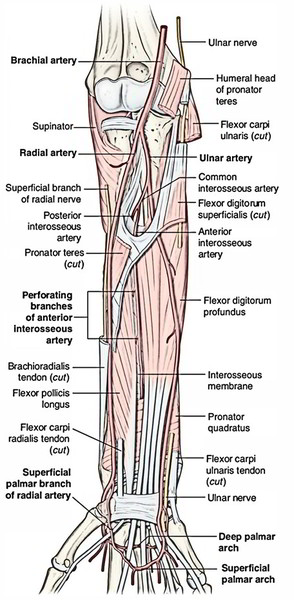The Ulnar Artery is the larger of the two terminal branches of the brachial artery. It supplies the medial aspect of the forearm, wrist, and hand. It starts just below the bend of the elbow and goes obliquely downward, reaching the ulnar side of the forearm near about midway between the elbow and the wrist. Ulnar Artery from there runs along the ulnar border to the wrist, where it splits into its two branches: the ulnar dorsal carpal branch and the ulnar superficial branch. The latter of these two divides into the superficial and deep palmar arches, supplying the palm of the hand. The ulnar artery also has several branches near the elbow joint. These branches and their extensions include:
- Common interosseous
- Anterior interosseous
- Interosseous recurrent
- Ulnar recurrent
- Ulnar recurrent, anterior
- Ulnar recurrent, posterior

Beginning
Opposite the neck of the radius, around 1 cm below the bend of the elbow.
End
It ends into superficial and deep branches in the palm.
Course
- Ulnar artery starts from within the cubital fossa at the level of the neck of the radius (or 1 cm distal to the flexion crease of the elbow). It runs downwards and in midway it hits the medial side of the forearm between the elbow and wrist. The course is oblique in the upper one-third of forearm (i.e., downwards and medially) but vertical in lower two-third.
- The median nerve is located medial to the artery 2.5 cm distal to the elbow and after that crosses the artery.
- The ulnar nerve is located medial to the distal two-third of the artery.
- It goes into the palm by passing in front of flexor retinaculum lateral to the ulnar nerve and the pisiform bone. It ends in the hand by splitting into large superficial and small deep branches. The superficial branch– the continuation of the artery superficial palmar arch, which in turn anastomosis with superficial palmar branch of the radial artery.
Relations
In the upper part of its course, it is located deep to superficial flexor muscles. In the lower part of its course, it ends up being superficial and is located between the tendons of flexor carpiulnaris and flexor digitorum superficialis. The details are as following:
Anterior: The upper part of the ulnar artery is covered up by 5 superficial muscles of the forearm, viz.
- Pronator teres.
- Flexor carpi radialis.
- Palmaris longus.
- Flexor digitorum superficialis.
- Flexor carpi ulnaris.
The lower part of the ulnar artery is covered merely by the skin and superficial and deep fasciae.
Posterior:
- Only the origin of ulnar artery is located on brachialis, while in the remaining whole part of its course it is located on flexor digitorum profundus.
Medial:
- Ulnar nerve.
- Flexor carpi ulnaris.
Lateral:
- Flexor digitorum superficialis.
Branches
- Muscular branches to neighboring muscles.
- Anterior and posterior ulnar collateral (recurrent) arteries, which join the arterial anastomosis around the elbow joint.
- Common interosseous artery, which stems from the upper part of the ulnar artery and after a very short course at the upper border of interosseous membrane, it splits into anterior and posterior interosseous arteries.
- Anterior and posterior ulnar carpal branches, which join the formation of anterior and posterior carpal arches.
- Terminal branches are two, the larger superficial branch continues as the superficial palmar arch, while the smaller deep branch takes part in the deep palmar arch.
Clinical Significance
Aberrant ulnar artery: In about 3% of human beings, the ulnar artery may arise high in the arm and passes superficial to the flexor muscles of the forearm and is called superficial ulnar artery. This variation ought to always be kept in mind while taking out blood samples or giving intravenous injections, since if superficial ulnar artery is mistaken for a vein it may be damaged and produce bleeding. Moreover, if an irritating drug is injected into the aberrant artery, the outcome could be fatal.

 (58 votes, average: 4.72 out of 5)
(58 votes, average: 4.72 out of 5)